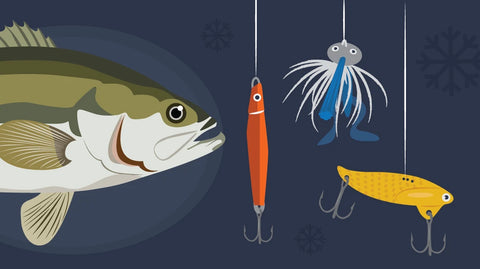Table of Contents
6 Tips for Winter Bass Fishing
The wintertime can be the most miserable time to approach bass fishing. Both the water and air temperatures seem to keep getting colder and, as a result, the bass are pretty darn sluggish right now. Bass don’t eat the whole day and don’t need so much food as often. For the more lethargic bass, some extra incentive may be needed before they take the bait.

Preparation and Safety
Make a plan of where you want to fish and be sure to let someone know where you are going and what part of the lake you will be fishing. If going alone, use extra caution, but ultimately, do your best to find someone to go with you.
When it comes to keeping warm, dress in layers and be sure to bring extra clothing in case you get wet or fall in. Layering is the best way to stay warm all day. Start with a base layer of a thermal shirt, pants, and socks. On top of that, use a fleece jacket and shirt for your middle layer. This will proide the most breathability and ensure you stay as warm as possible. A good outer layer is a rainproof set of pants or a bib and jacket.
Wearing multiple layers in a heated vehicle on your way to the lake will do more harm than good. Instead, add your final layer only when you arrive at the lake and begin to fish. Hand warmers and wool gloves with exposed fingers work well for keeping your hands warm and functional.

Use the Correct Lure
Winter fishing techniques are much more streamlined than those for other seasons. There are several lure options that are a little more effective for the winter months than others. Throw out the idea of using topwater and fast-moving lure- they’ll only waste your time. Here are a couple of lure options that should do the trick:
Football Head Jigs: These lures are created to imitate the look of crawfish. Pick a color that would mirror the color of true crawfish in your area (usually green or brown works well) and get your best chance at a catch by dragging the lure slowly along the bottom of the body of water. The slower, the better.
Jerkbait: A suspending jerkbait is a popular choice among winter anglers, but it comes with a caveat. It should only be used in fairly clean water, or else it won’t be visible to the fish. The experts recommend using these around underwater structures.
Metal Baits: Tough metal baits like spoons and blades hold up well to cold water. They’re super accessible, easy to use, and imitate injured or dying baitfish super well.

Slow Your Bait’s Movement
You need to slow down your presentation when the water temperatures drop. Winter largemouth bass fishing requires you to think like a fish. The water is cold, their metabolism is slow, and they’re not feeding much, so they will never chase a fast-moving topwater spinnerbait halfway across the pond; it won’t work.
Because bass will be moving much slower in the cold weather, they’re more likely to go for a bite they don’t have to fight for. Keep your bait near the bottom of the body of water, and keep it steady.

Master your Understanding of Water Temperature
One of the most important things in all of bass fishing is water temperature. The temperature is what keeps the bass moving shallow to deep, and also lets them know when to spawn. It signals the end of a season and gets the fish moving to a different phase.
Under 40 Degrees
This is one of the most challenging times to fish for bass, but it can be done. Bass in water below 40 degrees will be inactive and require an easy meal. This means the angler must get the bait right in front of the bass for it to strike.
40 to 50 Degrees
These are prime winter fishing temperatures. Bass living in these conditions will have slowed down their feeding, but are not too cold to eat. They will chase lures to some degree and are likely to be caught on a number of baits.
50 to 60 Degrees
Bass living in these temperatures are willing to bite a wide range of lures. These are not typical winter temperatures for much of the country, but in Southern waters they may be the coldest time of the year. These temperatures are also when the bass are transitioning from season to season, either from fall to winter or winter to spring. Generally, these are excellent fishing conditions anywhere in the country.

Find the Right Time

Be Patient
You don’t need to overcomplicate these winter bass fishing tips, but the most important one to remember is to stay calm and remain patient because winter bass fishing is not easy, but it’s also not impossible.
Once you’re on the water, a great technique that does require a good amount of patience is a “jerk, jerk, pause” cadence. After a couple wiggles, let your bait rest for at least ten seconds, if not more.
This will draw your catch to a bite. Remember, in winter bass fishing patience makes perfect. Let’s enjoy fishing! 
